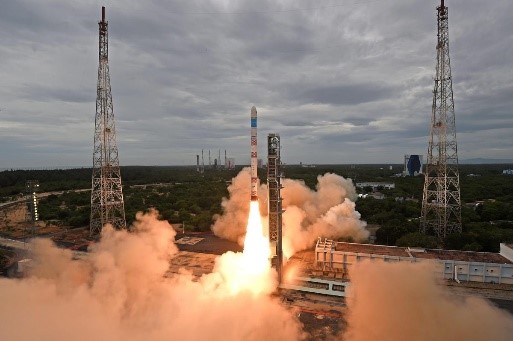ISRO launch of SSLV
ISRO launch of SSLV

Why in news?
On August 7, ISRO was ready for the first developmental flight of the SSLV-D1/EOS-2 mission. The launch took place from the Satish Dhawan Space Centre at Sriharikota. The Small Satellite Launch Vehicle (SSLV) D1/EOS-2 mission, was carrying two satellites — the Earth Observation Satellite-2 (EOS-2) which weighed about 135 kg and AzadiSAT which weighed about eight kg.
Aim of the mission:
- The mission aimed to place the EOS-2 in a circular low-Earth orbit at a height of about 350 km above the Equator and inclined at an angle of 37 degrees.
Failure of the mission:
- the mission failed to place the satellites in their required orbits, and the satellites, as they were already detached from the launch vehicle, were lost.
What was the purpose of the SSLV-D1/EOS-2 mission?
- The purpose of this mission was to place the two satellites in circular low-Earth orbits at a height of about 350 km above the Equator. The larger one, the EOS-2 which was designed and developed by ISRO, offered advanced optical remote sensing operations. It would have operated in the infrared region and could have served many purposes, from imaging for climate studies to simply keeping an eye on Earth.
- AzadiSAT, on the other hand, was a collective of 75 tiny payloads weighing around 50 grams each, which were integrated by students. It carried tiny experiments which would have measured the ionising radiation in its orbit and also a transponder which worked in the ham radio frequency to enable amateur operators to access it.
where did it fail?
- it was announced that there was a malfunctioning of a sensor which resulted in placing the satellites in an elliptical orbit, rather than a circular orbit. The ellipse or oval shape of the elliptical orbit is elongated in one direction and compressed in another (the so-called major and minor axes, which are like two radii of the ellipse). The shortest height above the Earth of this oval orbit was only about 76 km.
Why were the satellites lost?
- If the closest distance to the Earth is only 76 km, as it happened this time, there is an atmospheric drag experienced by the object at that height. Thereafter, unless adequate thrust is applied to overcome the drag, it will lose height and fall towards the Earth because of gravity and may eventually burn up due to friction.
Why do we need to develop an SSLV when we have successfully used PSLV and GSLV?
- The PSLV (Polar Satellite Launch Vehicle) and GSLV (Geosynchronous Satellite Launch Vehicle) are quite powerful and can carry huge loads. To place an Earth Orbiting Satellite in a low Earth orbit, one does not need such power horses.
- The SSLV can easily carry small-to-medium loads from 10 kg to 500 kg. It is less expensive. The three stages being powered by solid fuel is another advantage. Solid fuel is easier to handle, whereas handling the liquid propellants used in the PSLV and GSLV is more complex.
What is the difference between circular and elliptical orbits?
- Mostly objects such as satellites and spacecrafts are put in elliptical orbits only temporarily. They are then either pushed up to circular orbits at a greater height or the acceleration is increased until the trajectory changes from an ellipse to a hyperbola and the spacecraft escapes the gravity of the Earth in order to move further into space — for example, to the Moon or Mars or further away.
-
Satellites that orbit the Earth are mostly placed in circular orbits. One reason is that if the satellite is used for imaging the Earth, it is easier if it has a fixed distance from the Earth. If the distance keeps changing as in an elliptical orbit, keeping the cameras focussed can become complicated.

